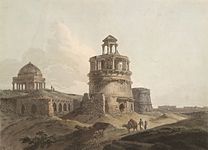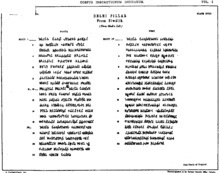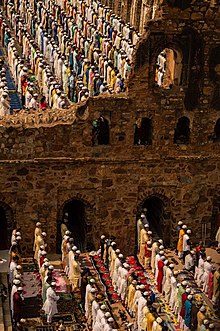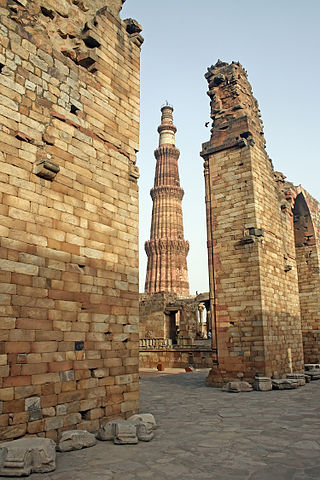
The Qutb Minar complex are monuments and buildings from the Delhi Sultanate at Mehrauli in Delhi, India. Construction of the Qutub Minar "victory tower" in the complex, named after the religious figure Sufi Saint Khwaja Qutbuddin Bakhtiar Kaki, was begun by Qutb-ud-din Aibak, who later became the first Sultan of Delhi of the Mamluk dynasty. It was continued by his successor Iltutmish, and finally completed much later by Firoz Shah Tughlaq, a Sultan of Delhi from the Tughlaq dynasty (1320–1412) in 1368 AD. The Qubbat-ul-Islam Mosque, later corrupted into Quwwat-ul Islam, stands next to the Qutb Minar.

Sultan Firuz Shah Tughlaq was a Muslim ruler from the Tughlaq dynasty, who reigned over the Sultanate of Delhi from 1351 to 1388. He succeeded his uncle Muhammad bin Tughlaq following the latter's death at Thatta in Sindh, where Muhammad bin Tughlaq had gone in pursuit of Taghi the rebellious Muslim governor of Gujarat. For the first time in the history of the Sultanate, a situation was confronted wherein nobody was ready to accept the reins of power. With much difficulty, the camp followers convinced Firoz to accept the responsibility. In fact, Khwaja Jahan, the Wazir of Muhammad bin Tughlaq had placed a small boy on the throne claiming him to be the son of Muhammad bin Tughlaq, who meekly surrendered afterwards. Due to widespread unrest, his realm was much smaller than Muhammad's. Tughlaq was forced by rebellions to concede virtual independence to Bengal and other provinces. He established Sharia across his realm.

The pillars of Ashoka are a series of monolithic pillars dispersed throughout the Indian subcontinent, erected—or at least inscribed with edicts—by the 3rd Mauryan Emperor Ashoka the Great, who reigned from c. 268 to 232 BC. Ashoka used the expression Dhaṃma thaṃbhā, i.e. "pillars of the Dharma" to describe his own pillars. These pillars constitute important monuments of the architecture of India, most of them exhibiting the characteristic Mauryan polish. Twenty of the pillars erected by Ashoka still survive, including those with inscriptions of his edicts. Only a few with animal capitals survive of which seven complete specimens are known. Two pillars were relocated by Firuz Shah Tughlaq to Delhi. Several pillars were relocated later by Mughal Empire rulers, the animal capitals being removed. Averaging between 12 and 15 m in height, and weighing up to 50 tons each, the pillars were dragged, sometimes hundreds of miles, to where they were erected.
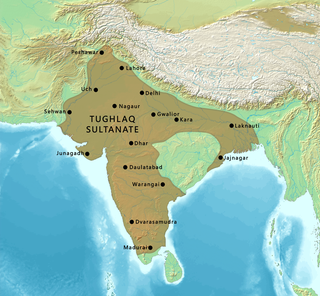
The Tughlaq dynasty was the third dynasty to rule over the Delhi sultanate in medieval India. Its reign started in 1320 in Delhi when Ghazi Malik assumed the throne under the title of Ghiyath al-Din Tughluq. The dynasty ended in 1413.

Purana Qila is one of the oldest forts in Delhi, India. The Old Fort was called the Inderpat during the Hindu rule, the Shergarh during the rule of Surid Sultan Sher Shah Suri, the Din Panah during the rule of second Mughal Emperor Humayun, each of whom made alterations and/or constructed additional buildings. As per the legends, during the reign of Emperor Ashoka the Great, who ruled around 332 BCE from his caputal in Magadh, some buildings were constructed here. It is thought by many to be located on the site of the ancient city of Indraprastha. The fort forms the inner citadel of the city of Dinpanah. It is located near the expansive Pragati Maidan exhibition ground and is separated from the Dhyanchand Stadium by the Mathura Road, Delhi.
Tughluqabad Fort is a ruined fort in Delhi, India. It was constructed by Ghiyasuddin Tughluq, the founder of the Tughlaq dynasty, of the Delhi Sultanate in 1321 as he established the third historic city of Delhi, but it was later abandoned in 1327. It lends its name to the nearby Tughluqabad residential-commercial area as well as the Tughluqabad Institutional Area. Ghiyasuddin Tughluq also built the Qutub-Badarpur Road, which connected the new city to the Grand Trunk Road. The road is now known as Mehrauli-Badarpur Road. The entry fee for the Fort is Rs. 20 for Indians. Also, nearby is Dr. Karni Singh Shooting Range and Okhla Industrial Area.

Lal Kot or Qila Rai Pithora is a fortified complex in present-day Delhi, which includes the Qutb Minar complex. It was constructed in the reign of Tomar Rajput king Anangpal Tomar between c. 1052 - c.1060 CE. It is termed as the "First city of Delhi". Remains of the fort walls are scattered across South Delhi, visible in present Saket, Mehrauli around Qutb complex, Sanjay Van, Kishangarh and Vasant Kunj areas.

Delhi has been an important political centre of India as the capital of several empires. The recorded history of Delhi begins with the 8th century Tomar Rajputs kingdom. It is considered to be a city built, destroyed and rebuilt several times, as outsiders who successfully invaded the Indian subcontinent would ransack the existing capital city in Delhi, and those who came to conquer and stay would be so impressed by the city's strategic location as to make it their capital and rebuild it in their own way.
Fatehabad is a town and a municipal council in Fatehabad district in the state of Haryana, India. It is the administrative headquarters of Fatehabad district.

Sultan Ghari was the first Islamic Mausoleum (tomb) built in 1231 AD for Prince Nasiruddin Mahmud, eldest son of Iltumish, in the "funerary landscape of Delhi" in the Nangal Dewat Forest, Near Nangal Dewat Vasant Kunj).

Khirki Mosque, approached from the Khirki Village in South Delhi and close to the Satpula or the seven arched bridge on the edge of southern wall of Jahanpanah, was a mosque built by Khan-i-Jahan Junan Shah, the prime minister of Feroz Shah Tughlaq (1351–1388) of the Tughlaq Dynasty. The word 'Khirki' prefixed to mosque is an Urdu word that means "window" and hence is also called "The Mosque of Windows".

Siri Fort, in the city of New Delhi, was built during the rule of Alauddin Khalji, second ruler of Khalji Dynasty, of Delhi Sultanate to defend the city from the onslaught of the Mongols. It was the second of the seven cities of medieval Delhi built around 1303, which at present is seen only in ruins with a few remnants due to its poor quality construction as compared to previous fort constructions in India (pictured

Jahanpanah was the fourth medieval city of Delhi established in 1326–1327 by Muhammad bin Tughlaq (1325–51), of the Delhi Sultanate. To address the constant threat of the Mongols, Tughlaq built the fortified city of Jahanpanah subsuming the Adilabad fort that had been built in the 14th century and also all the establishments lying between Qila Rai Pithora and Siri Fort. Neither the city nor the fort has survived. Many reasons have been offered for such a situation. One of which is stated as the idiosyncratic rule of Mohammed bin Tughlaq when inexplicably he shifted the capital to Daulatabad in the Deccan and came back to Delhi soon after.

The Gates of Delhi were city gates at various medieval townships around Delhi, built under dynastic rulers in the period that could be dated from the 8th century to the 20th century. They are the gates in:

The Ashokan edicts in Delhi are a series of edicts on the teachings of Buddha created by Ashoka, the Mauryan Emperor who ruled in the Indian subcontinent during the 3rd century BC. The Edicts of Ashoka were either carved on in-situ rocks or engraved on pillars erected throughout the empire; examples of both are found in Delhi.

Firoz Shah palace complex (Hisar-e-Firoza) is an archaeological complex located in modern-day Hisar, in the Haryana state of India, built by Firoz Shah Tughlaq of the Delhi Sultanate in 1354 AD. It is maintained by the Archaeological Survey of India.
Topra, combined name for the larger Topra Kalan and adjacent smaller Topra Khurd, is a Mauryan Empire-era village in Yamunanagar district of Haryana state in India. It lies 14 km west of Yamunanagar, 14 km from Radaur and 90 km from Chandigarh.
The Architecture of Delhi dates back more than a thousand years. As the capital of several great empires of India, including Rajput kingdom, Delhi Sultanate, Mughal Empire, and British Raj, the city of Delhi has been a centre for art and architecture.

The Delhi-Topra pillar is one of the pillars of Ashoka, inscribed with the moral edicts promulgated by Ashoka, the Mauryan Emperor who ruled in the Indian subcontinent during the 3rd century BCE. The Edicts of Ashoka were either carved on in-situ rocks or engraved on pillars erected throughout the empire. The pillar, originally erected in Topra Kalan, was transferred to Delhi in the 14th century by Feroz Shah Tughlaq.



